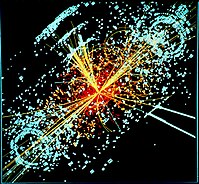
Photo from wikipedia
Abstract Sum rules for structure functions and their twist-2 relations have important roles in constraining their magnitudes and x dependencies and in studying higher-twist effects. The Wandzura-Wilczek (WW) relation and… Click to show full abstract
Abstract Sum rules for structure functions and their twist-2 relations have important roles in constraining their magnitudes and x dependencies and in studying higher-twist effects. The Wandzura-Wilczek (WW) relation and the Burkhardt-Cottingham (BC) sum rule are such examples for the polarized structure functions g1 and g2. Recently, new twist-3 and twist-4 parton distribution functions were proposed for spin-1 hadrons, so that it became possible to investigate spin-1 structure functions including higher-twist ones. We show in this work that an analogous twist-2 relation and a sum rule exist for the tensor-polarized parton distribution functions f1LL and fLT, where f1LL is a twist-2 function and fLT is a twist-3 one. Namely, the twist-2 part of fLT is expressed by an integral of f1LL (or b1) and the integral of the function f2LT = (2/3)fLT− f1LL over x vanishes. If the parton-model sum rule for f1LL (b1) is applied by assuming vanishing tensor-polarized antiquark distributions, another sum rule also exists for fLT itself. These relations should be valuable for studying tensor-polarized distribution functions of spin-1 hadrons and for separating twist-2 components from higher-twist terms, as the WW relation and BC sum rule have been used for investigating x dependence and higher-twist effects in g2. In deriving these relations, we indicate that four twist-3 multiparton distribution functions FLT, GLT, $$ {H}_{LL}^{\perp } $$ H LL ⊥ , and HTT exist for tensor-polarized spin-1 hadrons. These multiparton distribution functions are also interesting to probe multiparton correlations in spin-1 hadrons. In the near future, we expect that physics of spin-1 hadrons will become a popular topic, since there are experimental projects to investigate spin structure of the spin-1 deuteron at the Jefferson Laboratory, the Fermilab, the nuclotron-based ion collider facility, the electron-ion colliders in US and China in 2020’s and 2030’s.
Journal Title: Journal of High Energy Physics
Year Published: 2021
Link to full text (if available)
Share on Social Media: Sign Up to like & get
recommendations!